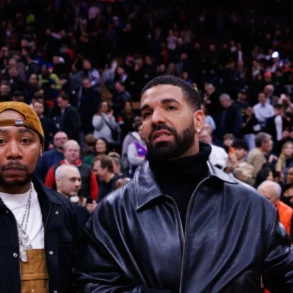The title of Questlove’s new book, “Hip-Hop Is History,” has a double meaning. The drummer and co-frontman of the Roots makes a convincing case not only that hip-hop is a pivotal piece of cultural history, but also that to some extent it is history, as in an art form “that has run its course in some important ways.”
The occasion for this analysis is the 50th anniversary of hip-hop, which arguably got its start at a Bronx house party in 1973. How has it evolved since, and where will it go, Questlove asks, and more pointedly: How long should hip-hop remain the apple of our eyes, if we know there’s a worm at its core? “So much of hip-hop is a reflection of pain, even the joyful parts,” he writes. “It only existed in the first place because public school music education was so woefully underfunded. Black kids wanted to play the trombone or the violin, but they weren’t getting instruments. That forced them to use the equivalent of food scraps, and ingenuity and genius turned those sonic scraps into a new genre.”
Over the course of 300-plus pages, Questlove uses his experience as an artist, DJ and producer to explore how that transformation happened. He is an affable and expert tour guide through the annals of hip-hop, as adept at spinning yarns as he is at spinning records. The book is organized according to five-year periods. Each half-decade is defined by its own drug du jour. Hip-hop’s embryonic stage occurred between 1979 and 1982, a period that Questlove argues was shaped by cocaine and rap’s close ancestor, disco. The genre shifted into its crack era from 1987 to 1992, weed wafted onto center stage from 1992 to 1997, and ecstasy brought hip-hop into a new millennium from 1997 to 2002, and so on, until we get to today’s aesthetic anesthetic: fentanyl. But, thankfully, “these periods aren’t just pharmaceutically distinct,” Questlove notes. “Each period had its own style, its own subjects, its own technology, its own culture.”
He considers the late 1980s and early ’90s to be the “golden age of hip-hop, when innovative MCs and innovative DJs seemed to spring up every few months, and classic albums regularly sprouted on the vine.” Much of his admiration for that period is indebted to Long Island agitprop all-stars Public Enemy. He credits the group as a kind of “Black CNN,” uniquely suited to capture and comment on the tectonic shifts happening in Black American life at the time. Public Enemy albums spliced Chuck D’s bracing social commentary with just enough humor from Flavor Flav to avoid tasting like cultural vegetables. Questlove doles out equal props to the group’s production team, the Bomb Squad, whose densely layered and cleverly allusive samples wove soul, funk and hip-hop staples into tuneful thick description.
To Questlove, hip-hop backslid from gold to spare change in the early 2000s. He cites 50 Cent’s song “Heat,” from 2003, which features a gun going off where you’d expect a snare drum to be, as a turning point. “The thing that had always fueled gangsta rap was the idea of the fear,” Questlove writes. “It maintained an air of mystery … the bluff was always more danger than the threat.” But once 50 Cent promised to kill his enemies on wax and dared the DA to play the song in a hypothetical court case against the rapper, “this lyrical brinkmanship … affected my perception of everything after that.”
Questlove, writing with Ben Greenman, is attentive to the genre’s splendor as well as its stumbles. He’s sympathetic to the aspirational and at times gleefully materialistic ethos of rap’s most mainstream figures (“sometimes the mathletes and the jocks can find common ground,” he writes), but firmly rejects the notion that anyone’s racks, stacks and bands could be your life. “The do-or-die atmosphere that solidified around stars like Jay-Z and Puffy was like a Monopoly game with only Boardwalk,” Questlove observes. “But that’s not how the game is played. While people were staring at the dark blue properties, I understood full well that I could hook some [things] up on the yellow, Marvin Gardens or Ventnor.”
As a writer and historian, Questlove, whose previous books include “Mo’ Meta Blues” (2013) and “Music Is History” (2021), has what musicians call pocket: close attunement to critical beats without excessive pomp or flash. His suggestions for further listening are organized by what he calls “the Thriller principle. What that means, in short, is that some songs are too obvious to add to the list.” The book ends with a thorough playlist of “songs I actually listen to.” It includes cuts as varied as British rapper, singer and actress Little Simz’s “Gorilla,” the jazzy, autobiographical bars of J-Live’s “A Charmed Life” and Kwest Tha Madd Lad’s unethical non-monogamy anthem “101 Things to Do While I’m With Your Girl.” Only a handful of songs by the Roots make the list.
Near its conclusion, the book veers cheekily into speculative fiction. Questlove writes from the perspective of himself at age 103, when a sentient computer enlists him to provide an introduction to a centennial edition of his book, later renamed “Hip-Hop Is Still History.” It’s during this Afrofuturist thought experiment that he coins the phrase “elastic fandom” — a resilient zeal and curiosity that drives devotees toward a genre’s newest movers and shakers after the listener’s personal heyday. The book’s very project acts as an advertisement for elastic fandom. It’s fondness without fanaticism; ardor with secure attachment steez.
From the vista of 2073, Questlove looks back on some of the major hip-hop-related developments that unfold after the book’s present. The advent of mind-dictation lets him compose the chapter straight off the top of the dome (a futuristic counterpart to freestyling). A non-hip-hop song by André 3000 is taken up as the new national anthem, while Big Boi, 3000’s former tag-team partner in OutKast, runs a successful gubernatorial campaign in Georgia.
But what’s most fanciful about Questlove’s vision of the future is his own survival. He’s dreaming his way toward rap’s epitaph, with the notable caveat that some of the genre’s vanguard lives long enough to write it. As the author sees it, breakbeats are irrevocably tethered to a gaping, historical brokenness, and so we must ultimately eschew them if Black America is ever to be made whole. He knows this is a bold gambit — and to the extent that his music criticism doubles as memoir, it’s a self-sacrificing one at that. But Questlove dares us to choose, for once, to love Black people over Black culture.
G’Ra Asim, a writer and musician, is an assistant professor of creative writing at Washington University in St. Louis and the author of “Boyz n the Void: A Mixtape to My Brother.”
Hip-Hop Is History
By Questlove with Ben Greenman
AUWA. 352 pp. $30
This post was originally published on this site be sure to check out more of their content.






